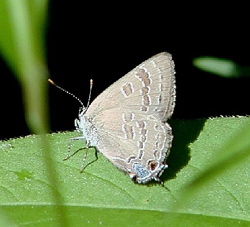Find a Butterfly
Hickory Hairstreak
Satyrium caryaevorum
Named
McDunnough, 1942

Identification
Wingspan: 1 - 1 1/4". Very similar to Banded Hairstreak (S. calanus); and distinguishable with certainty only by dissecting and comparing the male genitalia. The following wing characters cited in various guides as distinctive are not completely reliable despite the fact that a certain number of specimens will be found to show them unambiguously.
1. Underwing (postmedian) bands: Double in Hickory with dark center; generally single in Banded; if double, usually narrower than in Hickory.
2. Thecla spot: Orange crescent relatively narrow in Hickory, not thicker than the black spot beneath it; in Banded, orange crescent usually thicker than the black spot.
3. Male scent pads: Relatively slender in Hickory, about half the width of the discal cell in which it rests; fatter, more prominent in Banded, more than half the width of the discal cell.
Both Hickory and Banded can always be distinguished from Striped Hairstreak by the absence of an orange cap on the prominent blue spot at the lower corner of the underwing.
4. Blue anal spot extending beyond marginal spots and paler blue.
5. Male genitalia: The pair of prominent spines projecting inward from the vinculum, absent in Banded, is diagnostic.
Distribution
A patchy distribution mainly within the northeast quadrant of the continental United States: Missouri River in Iowa and eastern Minnesota south to northeastern Arkansas, east through southern Quebec and Ontario to southern New England, south along the coast to New Jersey and in the Appalachians to northern Georgia. In New England ranges only as far north as southernmost Vermont and New Hampshire. Not surprisingly, the species becomes less common northward as its preferred food plant (hickory) becomes scarcer.
Status in Massachusetts
A famously erratic species, being locally abundant in some years and apparently absent altogether in others. "Outbreaks" of the species have been recorded here only in the Southeast, where hickories are dominant forest trees. Seen by R. Robbins at Rock Meadow, Belmont (Middlesex Co.) and in Groveland Georgetown, and W. Boxford by R. Busby. Other records are scattered, and the pattern is further obscured by the difficulty of distinguishing the species from the common Banded Hairstreak.

Flight Period in Massachusetts
Late June to early August; mainly July. Extreme dates: 28 June 1966, Belmont (Middlesex Co.), Yale Collection, and 12 August 1970, Becket (Berkshire Co.), Yale Collection.
Larval Food Plants
The only confirmed host is Bitternut Hickory (Carya cordiformis); it may also use other hickories. Many other food plants, including, species of ash, oak and chestnut, have been erroneously reported in the literature. Adult Food Sources: As with all the mid summer hairstreaks, Hickory is found on Common Milkweed and New Jersey Tea.
Adult Food sources
Information for this species in Massachusetts is currently unavailable.
Habitat
Associated with deciduous woodlands where its larval foodplant (hickory) is dominant and nearby open areas where favorite nectar sources are available.
Life Cycle
EGG: Not described. Presumably a flattened pin cushion covered with a coarse beaded sculpturing like other Satyrium. OVIPOSITION: Presumably in crevices on twigs of host trees. LARVA: Slug-like and yellow-green, variously striped lengthwise in whitish and green, but stripes sometimes nearly lacking. Feeds on the undersides of leaves. CHRYSALIS: Smooth, slug-like, brown with darker mottling. PUPATION: Not described; presumably in bark crevices or in leaf litter at base of host trees. OVERWINTERING STAGE: Egg.
The adult habits are little known. Males are said to perch high in trees awaiting passing females. The causes of the apparent population booms and busts in this (and other hairstreak) species remain unexplained.
Account Author
Chris Leahy



